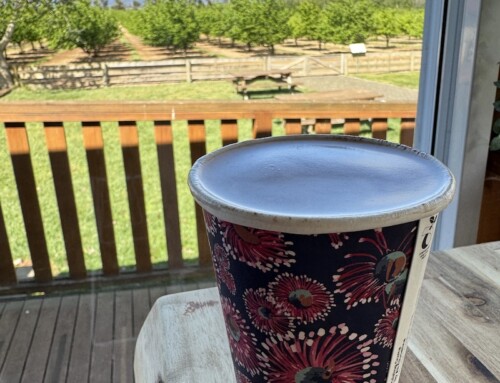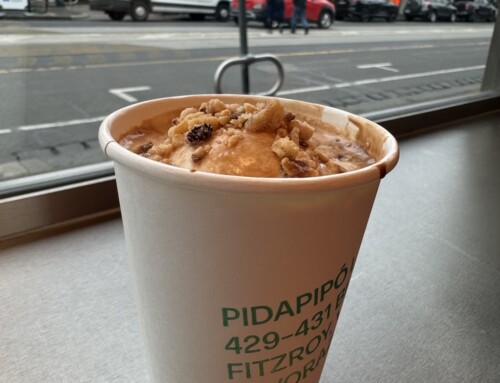
Cocoa is grown around the world within a band between 20 degrees north and south of the equator. While many have heard of cocoa from Ghana or Ecuador, Papua New Guinea or Vietnam, few realise that cocoa is also grown in Australia, primarily between Tully and Mossman in Far North Queensland. This area is also home to the Daintree Rainforest National Park and the Great Barrier Reef; both UNESCO world heritage listed.
In August 2022, I spent a week in Queensland learning about Australian cacao (check out my other posts to learn more). One of my favourite meetings was with Carmen, one of Queensland’s cocoa farmers and perhaps one of the most innovative ones. “Many of the cocoa farmers may have started off the same here, but over time everyone has diverged and done different things.” Carmen grows her cacao using only organic fertiliser, doesn’t spray for weeds and is focused on biodynamic and homeopathic methods of production. She uses seaweed and cocoa seed ferments as additional fertilisers. “I probably don’t have the highest yields compared to others, but still, I get a lot of pods.” A walk through the trees confirms this. There are beautiful ripe pods everywhere.
She starts picking in April/May until December, maybe January. Flowers come on through the year and if they developed into a pod, she’ll pick them. Last week she picked 800 kilograms of pods by herself, cutting them off one by one and throwing them into the pickup. “Some trees are getting a bit tall, especially the trees growing in the shade of the palms.” She tells me that she has several different varieties of cocoa grown, and although originally the seedlings were all from Papua New Guinea, each is a different colour, size, and shape. They all start off green, some then turn red, even purple and then as they ripen, they turn yellow or orange. Some have smooth skin, some much rougher. A few of her trees have cocoa pods that look like little round cannon balls “but they all have roughly the same number of seeds inside, regardless of the variety”.


Carmen opens up a bar of North Queensland Chocolate Company 80% cacao sweetened with coconut flower blossom for me to taste. The cocoa is not roasted in this chocolate which also includes raw cacao oil and North Queensland grown vanilla beans. “I used to sell to them. The maker is a musician who is also making chocolate”. Today she sells to another processor south of Cairns who processes the cocoa into cocoa powder and cocoa butter. “He always tests for heavy metals before he takes on a new farmer. That’s because a lot of the pods in this region are grown on ex sugar cane land and mercury used to be used as a fungicide in the fields and that stays on the land for years and years. A lot of inorganic fertilisers are also used and that all accumulates. Some cocoa growers get filter mud from the sugar mills (the remains after the cane juice is clarified and filtered) and that comes with a lot of extra minerals so you need to be careful how much you add to the soil. It all accumulates and ends up in the bean. Luckily my levels are very low here”.
Farmers here are paid by weight for their cocoa. “If you irrigate the trees, you get paid more because the pods are heavier. That doesn’t mean there are more beans though, the number of beans is the same”. Pods from different farms in the region are often mixed by the buyer before processing, as are the different sized pods. Carmen also mentioned that the price paid for the cacao does not depend on the methods you use in farming because the pods are all mixed together. “Whether you use chemicals or biodynamic as I do, all get the same pay. Ours apparently make a different sound though when opened, they look different, and they taste different”.
I ask Carmen if she chose to plant cocoa. She did, but her journey to cocoa was not a direct one. Originally from Germany, she studied agriculture and had always wanted to travel to Australia since she was 12 years old. “I grew up in East Germany behind the Iron Curtain so leaving East Germany was hard.” After finishing agriculture, she did work experience in Kununurra, Western Australia. “After that I worked in the sugar cane harvest and then worked driving a truck at the Argyle Diamond Mine. It was so boring, when you were down at the bottom of the pit doing 5km an hour…it was long, but you were paid well. I like cacao but I wish I could get the payment I used to get in the mines”.
Twenty-one years ago, she moved to Mossman with her partner Trevor to a farm that has been in his family for generations. Then fifteen years ago she was part of the same government sponsored programme that many other farms I have visited here were part of. The aim was to identify if cocoa could be grown in Australia and, if so, where. On Carmen’s farm, they used to grow sugar cane, like many in the area and then decided to diversify. “At the time cocoa was sold to farmers as being easy, had the potential for big yields and good money. They said that one person could easily do all the harvesting. We had two young kids at the time and there wasn’t a lot of money in sugar cane, so we thought we’d diversify”. At first cocoa did seem like the right decision, but then there were challenges finding buyers for the cocoa, and buyers that would pay.
She opened a pod for me and I immediately grab a seed and pop in my mouth. It may look the same, but it tasted different than the other seeds I’ve had on this trip. The pulp is more complex. I taste like lychee, peach, apricots, like a ripe tropical salad. I’d love to taste a bar made from these.
What about making your own chocolate I asked? “It seems very complicated, and then we have to do so many other things to sell it, do we really want to go there?”. We start talking about the price chocolate is sold for in the shops “people don’t think about it, they don’t know. How much do you think us farmers are making if you pay $1 for a bar? Nothing”. Instead, Carmen and her family enjoy the fresh seeds at home “The dogs love them too when they are raw. Roasted cacao is dangerous for them but fresh is fine. They have fun playing with the falling pods.”
Carmen often has other farmers interested in diversifying their crops asking about cocoa. “Its labour intensive though. You need to be able to irrigate which is expensive. The trees need pruning. You also have to pick over a long period and many people just want to do one harvest a year. It’s very labour intensive and labour is expensive in Australia, if you can even find anyone, which no one can at the moment. Then the big question is who you send the pods to, how do you get paid and how often and how much, and is that going to be reliable? We don’t get paid until others get paid as we are at the end of the food chain.” All the makers and farmers I have met with on this trip have all said the same thing; that the industry here is very political and very unclear. “Not only would the prices need to go up, but more support would also be needed by government and local councils, especially to help farmers to be able to ferment and dry their own beans which would result in higher prices.”
Is she going to stay in cacao? “When I see what’s going on in the sugar cane industry, I’m glad we aren’t there. Fertiliser prices are over $2000 a tonne when they used to be $800 and the soils are being degraded because of bad farming. We would have tried organic sugar but we don’t have the set up here for that to be processed. The sugar mills will process organic early in the season when the mills are clean but that means you need to harvest early when the sugar content isn’t as high. When things were bad we had a chance to move to other methods in the region, especially considering we are surrounded by the Daintree National Park, but the foresight wasn’t there and the opportunity was missed”.
I finish off by asking her if she likes being a cocoa farmer. She has a noticeable spark in her eyes as she answers “When I don’t pick for a long time, it can be overwhelming because you know you need to be in there weekly to pick. But when I’m there I just chill out and pick the pods and look at the trees. This is more rewarding, more stimulating. In farming you never stop learning, you learn little things every day. With biodynamics you learn to observe and look. You travel along, you look a bit more and trying to find these answers. I love farming, I have a passion for it.”








